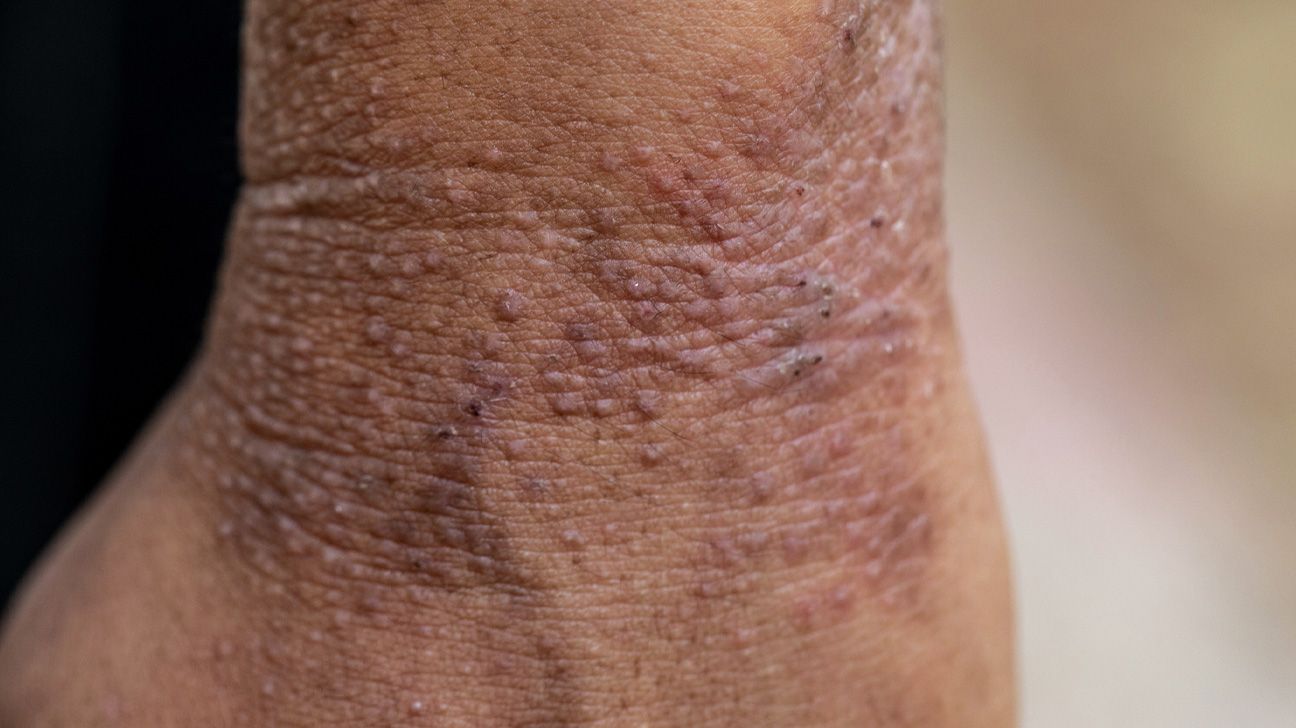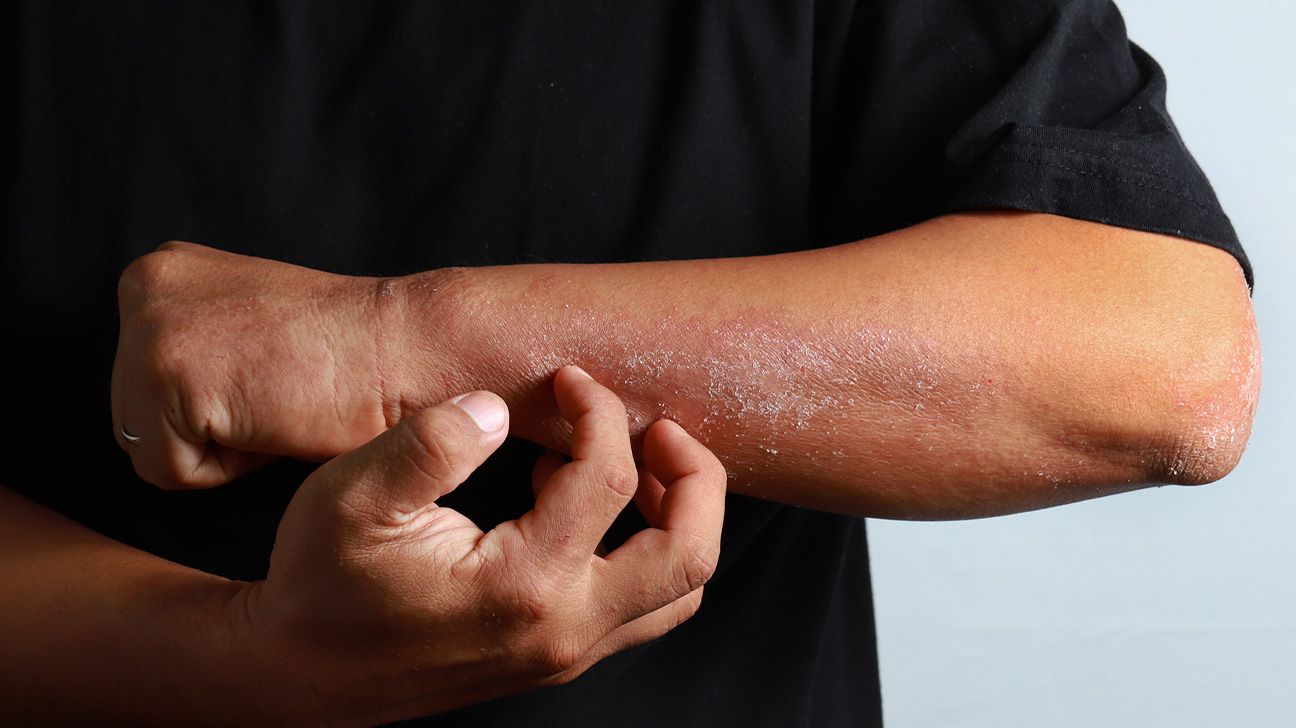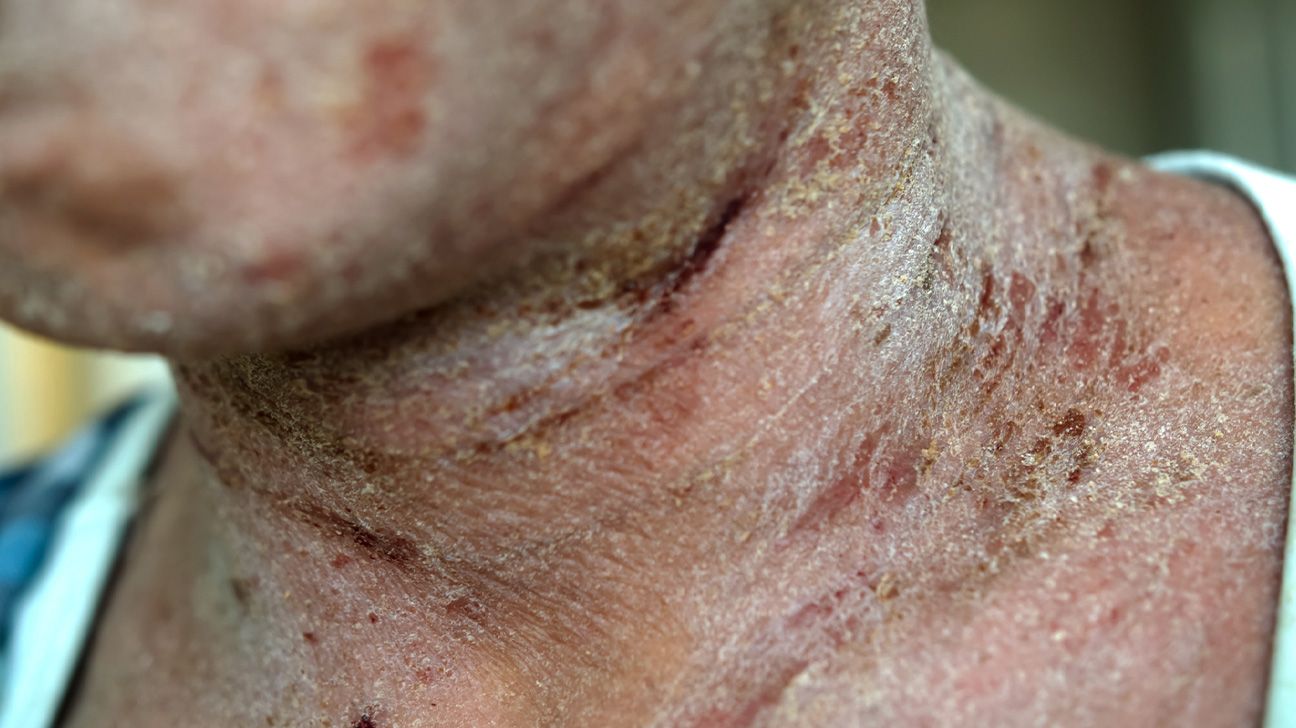Eczema can lead to inflamed, itchy, scaly patches of skin that are red or pink in lighter skin tones and more purple, brown, gray, and hyperpigmented in darker skin tones.

Most definitions of eczema describe how the condition and its symptoms affect lighter skin tones — but the condition affects people of color, too.
Below, we’ll describe eczema in greater detail, how it looks in darker skin compared to lighter skin tones, overall outlook, and ways to treat and manage eczema in people of color.
According to the National Eczema Association, 1 in 10 U.S. people have eczema.
Several types of eczema exist, but atopic dermatitis is the
While eczema can affect anyone, it’s more common — and more severe — in Black children compared to white children.
Black children also attend more frequent eczema-related doctor’s visits compared to white children, which results in higher out-of-pocket costs for managing the condition.
Meanwhile, adult-onset atopic dermatitis is more common in Asian countries compared with Western parts of the world.
Both Black and Hispanic children are also thought to have more severe cases compared to white children.







Many images of eczema show how it appears on lighter skin tones: red or pink and inflamed. However, eczema can appear quite different on darker skin tones.
Some signs to look for are patches of skin that:
- appear darker than the rest of your skin (hyperpigmented), which can include looking purple, ashen gray, or dark brown
- appear lighter than the rest of your skin (hypopigmentation), typically when healing from a flare
- contain small bumps (papules) on the chest, back, arms, or legs that often grow near hair follicles (follicular accentuation), which can cause body hair to stand on its end
- are thickened or firm (lichenification) with raised bumps (prurigo nodules), which can result from frequent scratching
- are very dry, cracked, or scaly
- feel warm to the touch
- itch intensely
Eczema may also appear at different locations. In people with lighter skin, eczema is often found at the inner creases of the elbows and knees.
Although eczema can also be found in these areas on people of color, it’s often located on the fronts of the arms or legs of people of African descent.
Several factors may contribute to some of the differences in eczema development in people of color.
Skin barrier
The skin serves as an important protective barrier between your environment and the rest of your body. People with eczema have changes associated with this skin barrier that make it easier for moisture to escape and for environmental irritants to affect dry skin — regardless of skin tone.
However, some believe that there are skin barrier differences in Black and Asian populations. This suggests racial variations of the skin barrier can play a role in the development of eczema in people of color.
Genetics
Several genetic factors have been associated with eczema.
For example, genetic variations leading to changes in the skin protein filaggrin have been strongly associated with eczema. However,
This suggests that additional genes related to the skin or the immune system are involved in the development of eczema in this population.
Environment
The worldwide prevalence of eczema
This includes:
- exposure to airborne irritants like cigarette smoke and pollution
- fast food consumption
- temperature extremes
- living in an urban area as opposed to a rural area
However, more research is needed to understand how environmental factors work together with other factors to increase eczema risk, particularly in people of color.
Immune system
An overreaction of the immune system plays a role in eczema. Researchers are working to understand immune system similarities and differences between racial and ethnic groups as it pertains to eczema.
Coming into contact with common irritants in your environment can easily activate the immune system, leading to a flare-up.
Currently, there’s no way to prevent eczema from developing.
But if you have eczema, there are steps you can take in your daily life to help reduce the risk of having a flare-up, regardless of your skin tone.
Start with these strategies:
- Avoid triggers: Try to avoid what causes your flare-ups (if you know). Triggers can be different for everyone but may include things like soaps, fragrances, or stress.
- Moisturize frequently: Use a fragrance-free lotion, cream, or ointment to add moisture to your skin. Good times to moisturize include right after showering and anytime your skin feels dry.
- Choose products carefully: Some soaps, detergents, and skin care products can irritate the skin and cause a flare-up. Focus on using fragrance-free products. Try to test them on a small area of skin before using them on larger areas.
- Change your shower routine: Try to limit your showers to about 10–15 minutes total, using water that’s warm but not hot. When you’re done showering, gently pat yourself dry with a clean towel and moisturize.
- Mind the temperature: Remember that some conditions can increase the risk of a flare. For example, colder temperatures can lead to drier skin that may require additional moisturizing.
- Clothe carefully: Aim to wear loose-fitting, breathable clothes while avoiding tight-fitting garments. Wash any new clothes prior to wearing them for the first time.
Tips for coping with eczema
Here are ways to soothe your skin and help relieve symptoms:
- Pamper your skin: Use gentle skin care methods. This includes regular moisturizing, using fragrance-free skin care products, and avoiding hot showers.
- Don’t scratch: While this is a good rule of thumb for anyone with eczema, repeated scratching of eczema on dark skin tones can potentially lead to skin thickening and pigmentation changes.
- Use sunscreen: If your eczema has caused hyperpigmentation, sun exposure can worsen it. If you will be outside, be sure to apply sunscreen first.
- Apply topical corticosteroids carefully: Topical corticosteroids are often used for eczema. But they can cause skin to become temporarily lighter than normal. Take care to only apply them to affected areas and only as your doctor instructs.
While most eczema care focuses on preventing flare-ups from occurring, treatment is also available to manage symptoms that occur and prevent future flares.
Generally speaking, eczema treatments are very similar across all races and ethnicities. They often involve the same combination of medications with other therapy types.
Medications
There are several types of medications that may be recommended for people with eczema, such as:
- Over-the-counter medications: Topical anti-itch creams containing hydrocortisone or oral antihistamines (Benadryl, Zyrtec, Allegra) may help to ease symptoms. Use topical hydrocortisone with caution.
- Prescription topical treatments: These topical treatments help to ease itching and inflammation. Examples can include topical corticosteroids and calcineurin inhibitors like tacrolimus (Protopic) and pimecrolimus (Elidel). If using a corticosteroid cream, ointment, or lotion on your skin, be careful to follow your doctor’s directions. Using too much may cause hypopigmentation, a lightening of that area of the skin.
- Oral corticosteroids: Oral corticosteroids like prednisone may be prescribed on a short-term basis for severe flare-ups.
- Phosphodiesterase 4 (PDE4) inhibitors: An option known as crisaborole (Eucrisa) is a specific type of topical steroid that helps treat mild to moderate symptoms.
- Biologics: Two injectable biologics, called dupilumab (Dupixent) and tralokinumab (Adbry), are available for treating severe cases of eczema. They work to reduce symptoms and prevent future flares.
- Janus kinase (JAK) inhibitors: Two oral JAK inhibitors, abrocitinib (Cibinqo) and upadacitinib (Rinvoq), and one topical version called ruxolitinib (Opzelura), are available for treating eczema. JAK inhibitors work to relieve eczema symptoms and prevent flares.
- Antibiotics: Scratching eczema-affected skin can potentially lead to a bacterial skin infection. When that occurs, it can be treated with topical or oral antibiotics.
Other therapies
In addition to medications, several other types of therapy can help with eczema:
- Light therapy: Light therapy may be an option if eczema is persistent or doesn’t respond well to medications. It involves exposing the skin to small, controlled amounts of UV light. However, it may not be recommended for darker skin tones if hyperpigmentation is a concern.
- Soak and smear: This technique involves applying moisturizer or topical medication directly after a shower or bath while the skin is still wet to help lock in moisture.
- Occlusion: This involves applying a topical treatment, then covering it with plastic wrap. You then leave it on for a few hours before removing.
- Wet dressings: This treatment may be helpful when eczema is widespread. It involves wrapping the affected area using topical treatments and wet bandages.
- Stress relief techniques: Stress can sometimes trigger an eczema flare-up. Because of this, trying stress relief techniques like yoga or meditation may be beneficial.
Help finding healthcare professionals to treat eczema
You can use the resources below to find a dermatologist in your area who specializes in treating eczema in skin of color:
- American Academy of Dermatology (AAD): The AAD website provides a search tool that you can use to find a board certified dermatologist in your area. You can use the search filters to find someone who focuses on skin of color.
- Skin of Color Society (SOCS): SOCS aims to raise awareness and champion excellence in the treatment of dermatologic conditions in skin of color. They’ve compiled an extensive searchable list of doctors on their website.
- National Eczema Association: The National Eczema Association website also has a search tool that you can use to find a doctor or other healthcare professional in your area who specializes in treating eczema.
Eczema can often be managed by maintaining good skin care habits and preventing anything that could trigger flare-ups. However, it’s still possible to experience occasional flare-ups from time to time.
People of color who have eczema have a higher risk of developing a condition called post-inflammatory dyspigmentation. This is a noticeable change in skin pigmentation, which can be either:
- hyperpigmentation, in which an area is darker than the surrounding skin
- hypopigmentation, which is when an area is lighter than the surrounding skin
These pigmentation changes often fade over a period of months. But severe eczema that results in frequent scratching or rubbing can lead to lasting changes.
Data from a 2019 study suggests that African American people with eczema have higher levels of inflammation in the skin.
This can lead to eczema that’s more difficult to treat, making timely treatments even more important in managing the condition.
Professionals are encouraging more people of color to sign up for studies and clinical trials to learn more about how this condition and its treatments affect them.
Historically, most descriptions of eczema only apply to lighter skin tones. But researchers are learning more about how this skin condition affects people of color.
Often, eczema in people of color, especially Black people, can appear darker than the surrounding skin, feel dry or thickened to the touch, and is intensely itchy. You may also have other symptoms, like dark circles under your eyes and bumps around hair follicles.
Eczema can be more severe in people of color, leading to potentially permanent pigmentation changes or skin thickening. Because of this, taking steps to manage the condition and seek care for it is very important.
